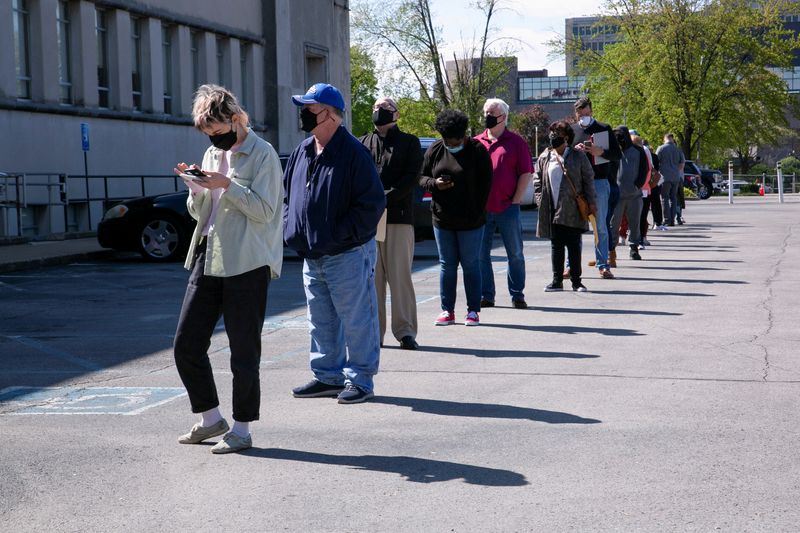By Lucia Mutikani
WASHINGTON (Reuters) - U.S. private payrolls fell for the first time in a year in January as soaring COVID-19 infections disrupted business operations, raising the risk of a sharp decline in employment that would deal a temporary setback to the labor market.
The surprise drop in payrolls in the ADP National Employment report on Wednesday was across all industries and business sizes. It added to a slowdown in manufacturing activity last month in suggesting that the economy lost significant momentum at the start of 2022 as coronavirus cases, driven by the Omicron variant, raged across the nation.
"The good news is that the job market should quickly bounce back as the Omicron variant fades," said Gus Faucher, chief economist at PNC Financial (NYSE:PNC) in Pittsburgh, Pennsylvania.
"Underlying demand in the economy is still strong, and businesses are still trying to hire. But the January drop in employment is another reminder that the economy will not fully return to normal until the pandemic is over."
Private payrolls decreased by 301,000 jobs last month, the first drop since December 2020, after increasing by 776,000 in December. Economists polled by Reuters had forecast private payrolls would increase by 207,000 jobs.
The broad decline in private payrolls was led by the leisure and hospitality sector, with 154,000 job losses. Trade, transportation and utilities shed 62,000 jobs. Manufacturing employment decreased by 21,000 jobs. Freezing temperatures last month were also a factor, with construction losing 10,000 jobs.
Employment at small businesses dropped by 144,000 jobs, while medium enterprises laid off 59,000 workers and large companies reduced payrolls by 98,000.
The ADP report is jointly developed with Moody's (NYSE:MCO) Analytics and was published ahead of the release on Friday of the Labor Department's more comprehensive and closely watched employment report for January. It has, however, a poor record predicting the private payrolls count in the department's Bureau of Labor Statistics employment report because of methodology differences.
The ADP report counts all active workers as employed regardless of whether they are paid or not during the survey week. In contrast, people who are out sick or in quarantine and do not get paid during the payrolls survey period are counted as unemployed in the BLS survey of establishments even if they still have a job with their companies.
The decline in private payrolls in the ADP report suggests that some workers were laid off because of reduced demand. Businesses were also probably unable to find workers, with so many people at home because of soaring infections.
Stocks on Wall Street were trading higher. The dollar fell against a basket of currencies. U.S. Treasury prices rose.
(Graphic: Omicron takes a bite out of private payrolls: https://graphics.reuters.com/USA-ECONOMY/klvykmdwqvg/chart.png)
MILLIONS AT HOME
Economic growth slowed in January, with an Institute for Supply Management survey on Tuesday showing its measure of national factory activity falling to a 14-month low.
The economy grew at a 6.9% annualized rate in the fourth quarter, helping to boost overall growth in 2021 to 5.7%, the strongest performance since 1984. Growth estimates for the first quarter are mostly below a 2.0% rate.
According to the U.S. Census Bureau's Household Pulse Survey published in mid-January, 8.8 million people reported not being at work because of coronavirus-related reasons between Dec. 29 and Jan. 10. This has left some economists bracing for a decline on Friday in the nonfarm payrolls count for January.
According to a Reuters survey of economists, nonfarm payrolls likely increased by 150,000 jobs last month. Estimates range from a decrease of 400,000 to an increase of 385,000. The economy created 199,000 jobs in December, the fewest in a year.
The White House has been frantically trying to prepare the nation for a disappointing payrolls number, with several officials offering a preview of the report.
"I think the key point, from our perspective, is the underlying strength of the economy," Jared Bernstein, a member of the White House's Council of Economic Advisers, told CNN this week. "The underlying strength of the job market is ongoing because, as we have seen, the caseloads are turning over."
The United States is reporting an average of 433,601 new COVID-19 infections a day, sharply down from the more than 700,000 in mid-January, according to a Reuters analysis of official data.
Demand for labor is strong, with fewer workers available. There were 10.9 million job openings at the end of December.
Economists expect the Federal Reserve will view a decline in payrolls in January as a blip, given the near-record vacancies.
The Fed last week said it was likely to raise interest rates in March. Economists expect as many as seven hikes this year to tame inflation.

The labor market is already rebounding as the Omicron wave subsides. First-time applications for unemployment benefits have retreated from a three-month high.
"The labor market is still in very good shape, regardless of what numbers print, and that points to continued solid wage increases as well," said Joel Naroff, chief economist at Naroff Economics in Holland, Pennsylvania.